Getting Started
New to Commons Baseball? Here's how to get your first game going:
- Find a friend: Commons Baseball is a head-to-head game, so you need to find someone to play with
- Grab 60 cards each: Each player needs 50 batters and 10 pitchers (any baseball cards with stats on the back will work for now)
- Get the Commons Baseball app: This will convert the player statistics into dice roll probabilities for you
- Print out the gameplay cards and cut them out: The baseball gods are here, and the inning numbers are here
- Find a die: Just one standard six-sided die
- Decide who's home team: Rock-paper-scissors works great!
- Play 9 innings: Take turns pitching and batting, rolling the die to see what happens
You can start playing right now and learn the finer details as you go. The rest of this guide will teach you everything you need to know to play like a pro.
What You Need
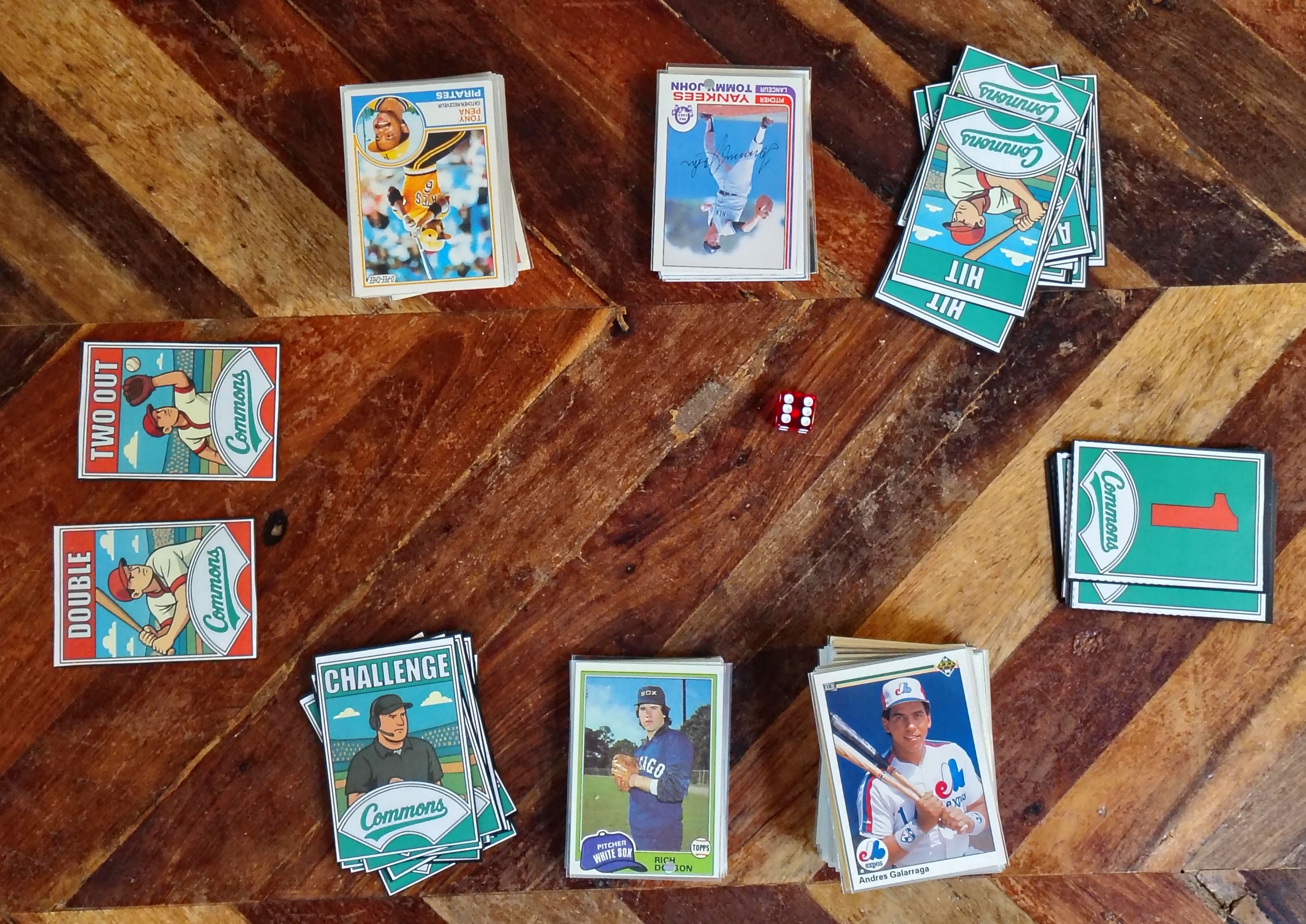
- Baseball Cards: Any cards with player statistics on the back (see "Legal Cards" section below)
- One Six-Sided Die: That's right, just one! The suspense is part of the fun
- Gameplay Cards: Print these from the website or make your own - you'll need Hit, Out, Advance, Challenge cards, and some inning numbers
- Commons Baseball app: Convert card stats into dice roll probabilities, needed if you haven't already got the probabilities printed out
Building Your Roster (Your "Deck")
Before you play, each player needs to build their roster. Think of this like building a deck in a card game - you're choosing which players will be on your team.
Roster Requirements:
- 60 total players: 50 batters and 10 pitchers
- Set Your Order: Arrange batters and pitchers in whatever order you like - this is your lineup!
- One Card Per Player: You can't have multiple cards of the same player, even from different years
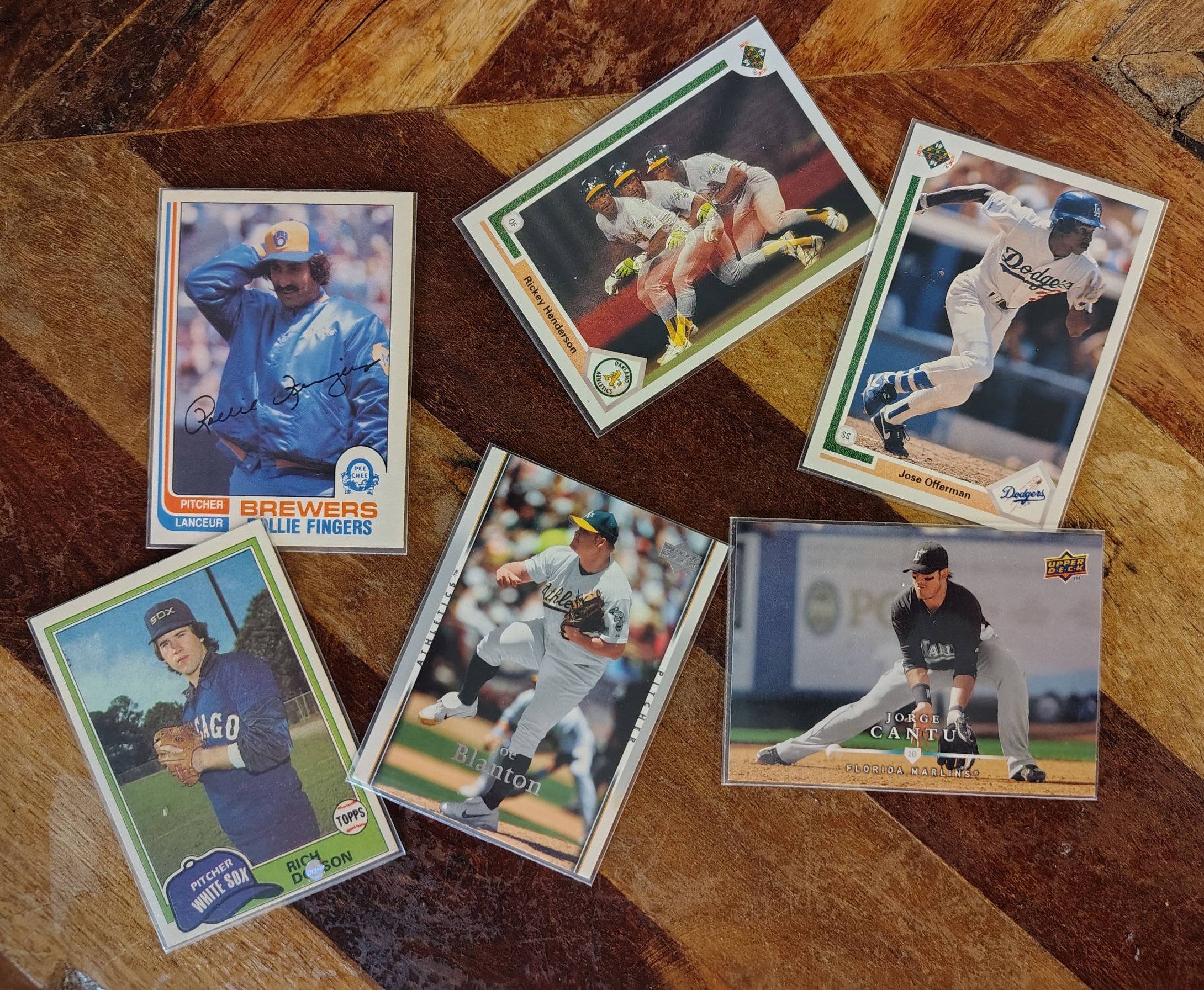
The Salary Cap - Keep It Fair (and Fun!)
Here's where Commons Baseball gets interesting. Every player in MLB history is ranked from 1 to 10 based on their stats for each season. Hall of Fame caliber years get a 10, terrible seasons get a 1, and most players fall somewhere in between.
Your entire 60-player roster must total 420 points or less (averaging 7 per player). Want to include that Rollie Fingers 10-ranked card? You'll need to balance it out with some lower-ranked commons to stay under the cap.
Why? This is the heart of the game's philosophy - it gives those dusty common cards a chance to shine. Instead of just stacking your roster with all-stars, you need to be creative and strategic. You'll find yourself appreciating players you never knew existed!
Understanding Card Seasons
Quick note on card years: A 1983 Topps card typically shows a player's stats from the 1982 season. Most cards represent the previous year's performance. Commons Baseball uses only the statistics from that specific "card season" - ignore career totals or other years shown on the card.
There are some cards that are reprints of older historic cards - these are perfectly legal to use in Commons Baseball, provided all the stats are printed on the card. That replica 1952 Topps Mickey Mantle? Go ahead and use it - even if it were printed in 2025 you will use the 1951 stats!
Legal Cards
Any card can be used in Commons Baseball as long as it meets these requirements:
Pitcher Cards Must Include:
- ERA (Earned Run Average)
- Innings Pitched
- Handedness (Left or Right)
- Walks
Batter Cards Must Include:
- Batting Average
- Doubles, Triples, Home Runs
- Handedness (Left, Right, or Both)
- At Bats
- Optional: Stolen Bases (since a lot of old cards don't have this stat, it's not required)
Not Valid: Special cards like commemoratives, some all-star cards, or checklists, etc. If it has stats on the back, it's valid. No stats? Sorry, gotta find another card!
Converting Cards to Dice Probabilities
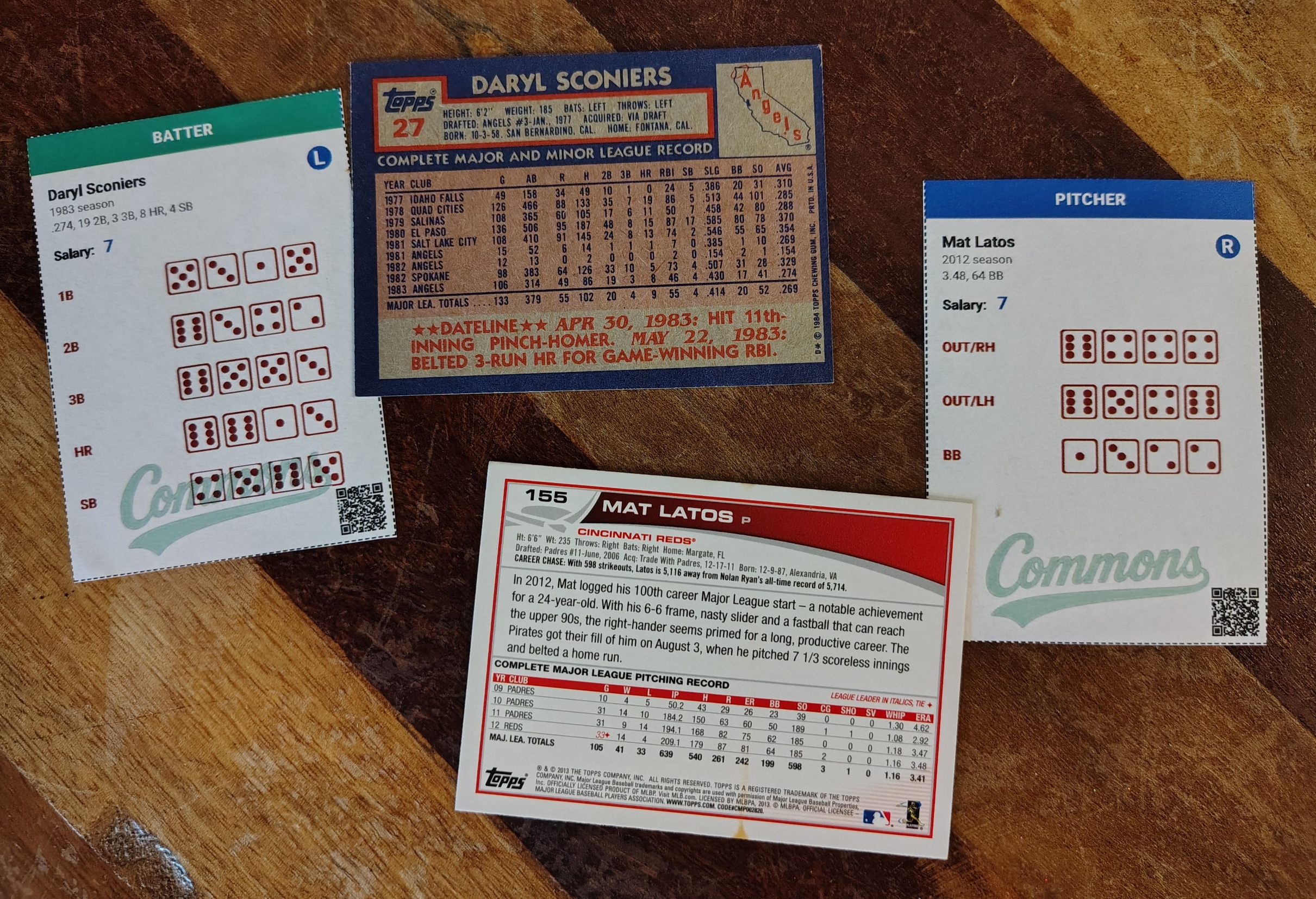
Before using a card in Commons Baseball, you need to convert the stats on the back into dice roll probabilities. Don't worry - it's easier than it sounds!
Use the App or Website - The Commons Baseball app does the math for you. Just build your roster in the app and print out probability sheets.
Option 1: Print Labels - The app can generate Avery 5160 address labels that you can stick directly onto penny sleeves.
Option 2: Print and Insert - Print probability sheets and insert them into penny sleeves along with the cards.
Option 3: Digital Only - You can just use the app to view the dice roll probabilities without printing anything out.
How Dice Rolls Work
Each card gets thresholds that look like 4-digit numbers (read left to right or top to bottom). You roll one die at a time, only as many times as needed to determine the outcome - maximum of 4 rolls per play.
Why one die? It's not really slower than using 4 dice at once, plus the suspense of rolling multiple times is way more fun! You'll be waiting to see if that fourth digit gives you a home run, or if it's a double off the wall.
Baseball Gods Cards - Your Secret Weapons
These cards are your strategic tools to change the game when you need it most. Use them wisely - once they're gone, they're gone!
Regular Baseball Gods (You Start With These)
- Hit Card (3 total): Automatically gives the batter a single without rolling. The pitch still must be delivered first (so the pitcher could still walk or automatically get the batter out).
- Out Card (3 total): Automatically gets the batter out without the pitcher needing to deliver a pitch. Can be challenged by the batting team.
- Advance Card (3 total): Advances one baserunner one additional base after a hit. Cannot be challenged. Cannot be used on the batter (e.g. cannot use it to turn a single into a double).
- Challenge Card (2 total): Cancels an opponent's Hit or Out card. If challenged, play proceeds normally with dice rolls. The challenged player cannot immediately play another baseball gods card.
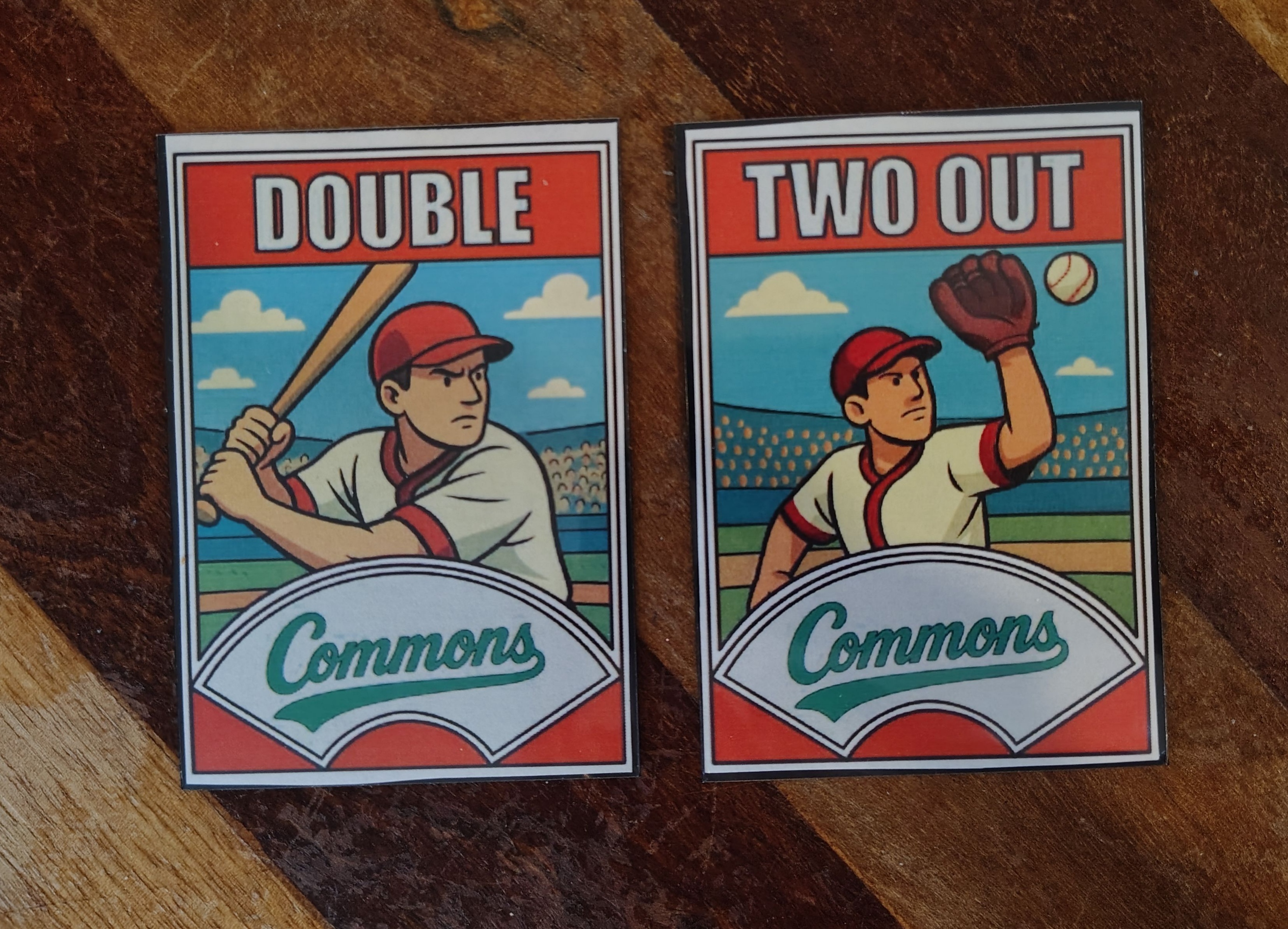
Super Gods - The Nuclear Options
There are two special cards that change everything:
- Double Super God: Automatic double for the batter. Cannot be challenged.
- 2 Outs Super God: Automatic 2 outs (current batter + next batter). Cannot be challenged. If played when there are already 2 outs, only the current batter is out - extra outs don't carry over to the next inning.
The Catch: Super gods are not assigned to anyone at the start. They sit in the middle of the table. As soon as one player uses a super god, the other super god immediately goes to their opponent to use whenever they want.
Game Setup
Step 1: Grab Your Baseball Gods
Each player starts with these special cards:
- 3 Hit cards
- 3 Out cards
- 3 Advance cards
- 2 Challenge cards
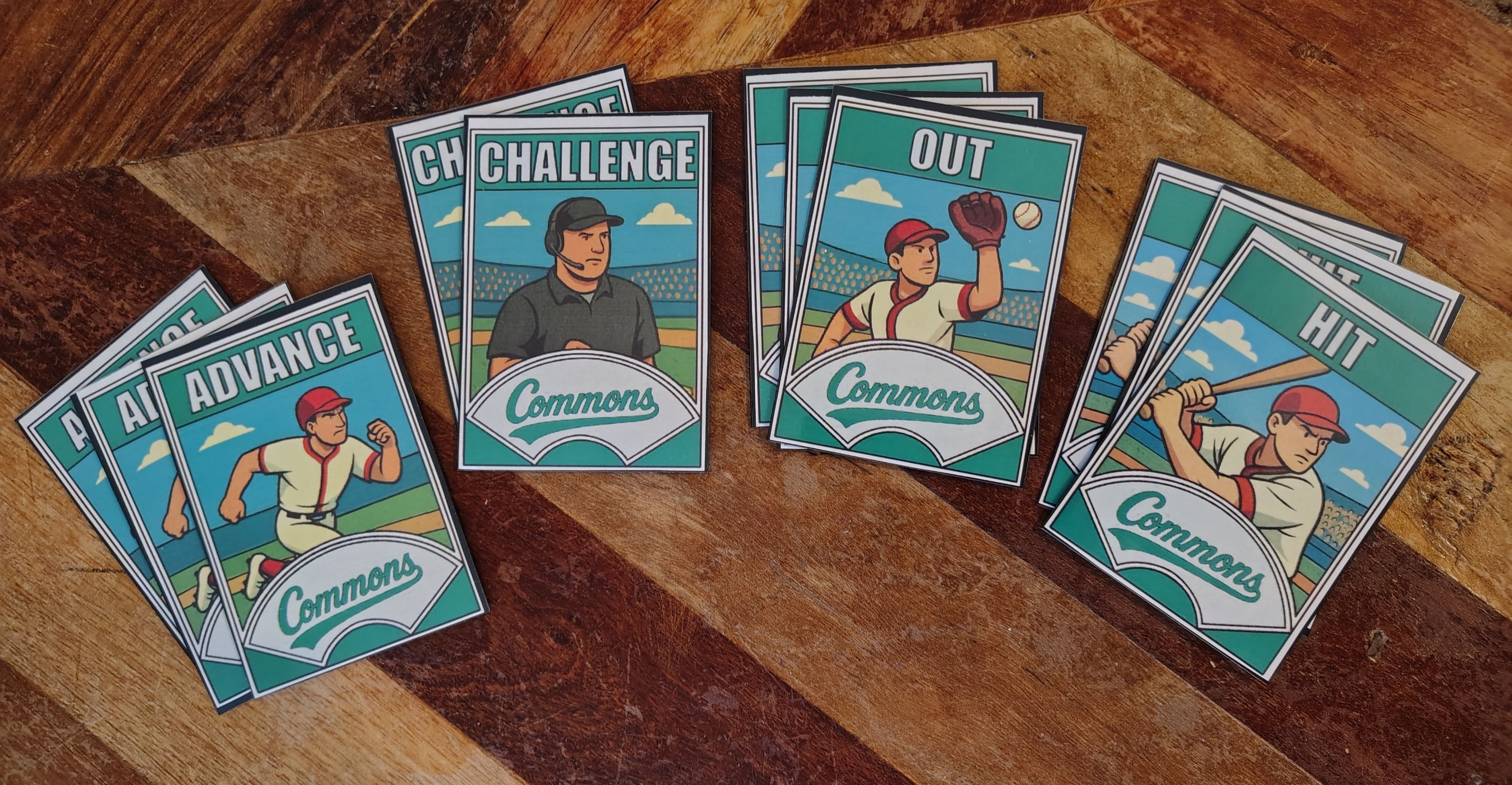
Step 2: Decide Home and Visiting Teams
Rock-paper-scissors is our official recommendation. Winner gets to choose!
Step 3: Play Ball!
The visiting team bats first (top of the 1st inning), and the home team pitches. Let's go!
Game Structure - How It Works
A game consists of 9 innings (or more if tied). Each inning has two halves:
- Top of the inning: Visiting team bats, home team pitches
- Bottom of the inning: Home team bats, visiting team pitches
Each half-inning continues until the batting team gets 3 outs. Then it's the other team's turn.
Special Rule: If the home team is winning after the top of the 9th inning, the bottom of the 9th is not played - game over, just like real baseball!
Selecting Pitchers Each Inning
At the start of each inning, both teams grab their next pitcher from their ordered roster. Important rules:
- Each pitcher can only throw a maximum of one inning (get 3 outs)
- You can skip a pitcher and use the next one in your list, but the skipped pitcher is discarded and unavailable for the rest of the game
- Be careful in close games - if you run out of pitchers, bad things happen (see "Running Out of Players" below)
The Turn Sequence - This Is Where the Magic Happens
Each time a pitcher throws to a batter, it's called a turn. Every turn has two phases: pitching and batting. Here's the complete sequence:
Phase 1: Before the Pitch (Defensive Options)
- Pitcher's Team: Play a Baseball Gods Card?
- You can play an "Out" or "2 Out" (super god) card
- If you don't play a card, continue to step 2
- Batter's Team: Challenge?
- If an "Out" card was played, you can play a "Challenge" card to cancel it
- The "2 Out" super god cannot be challenged
- If not challenged, the out(s) happen and the turn ends
Phase 2: The Pitch
- Pitcher's Team: Deliver the Pitch
- Intentional Walk: You can choose to walk the batter without rolling
- Roll to Pitch: Roll the die and check the pitcher card thresholds
Four Possible Pitch Outcomes:
- Automatic Out: Roll is higher than the "OUT" threshold on pitcher card → Batter is out, turn ends
- Automatic Hit: Roll is higher than the "HIT" threshold on pitcher card → Batter gets a single, turn ends
- Walk: Roll is lower than the "BB" threshold on pitcher card → Batter walks to first base, turn ends
- Pitch Delivered: None of the above → Continue to batting phase
Phase 3: Batting Phase (If Pitch Was Delivered)
- Batter's Team: Attempt to Steal?
- Only if there's a runner on first and the next base is open
- Roll the die - check steal thresholds on the back of the runner's card
- If the runner is out on a steal with 2 outs already, the inning ends but the batter stays in the lineup for next inning
- Batter's Team: Pinch Hit?
- Only for batters who played for multiple teams in the card season (both teams' stats shown on card back)
- Discard the current batter and replace with any remaining batter from your roster
- Use sparingly - you can run out of batters!
- Batter's Team: Play an Offensive Baseball Gods Card?
- Play a "Hit" card for an automatic single
- Or play a "Double" super god card for an automatic double
- Pitcher's Team: Challenge?
- If a "Hit" card was played, you can play a "Challenge" card to cancel it
- The "Double" super god cannot be challenged
- If not challenged, the hit happens and go to step 10
- Batter's Team: Swing for the Fences?
- Declare before rolling - any hit that's 2B or better becomes a home run!
- But any roll that would have been a single becomes an out instead
- High risk, high reward!
- Batter's Team: Roll to Swing (or Bunt)
- Bunt: Advance all runners (except for runner on third - no suicide squeeze plays here!) one base, add one out, turn ends. You need to roll one die to see if the bunt was successful - roll anything higher than a 1 and it's good, otherwise the batter is out.
- Swing: Roll the die and check the batter card thresholds
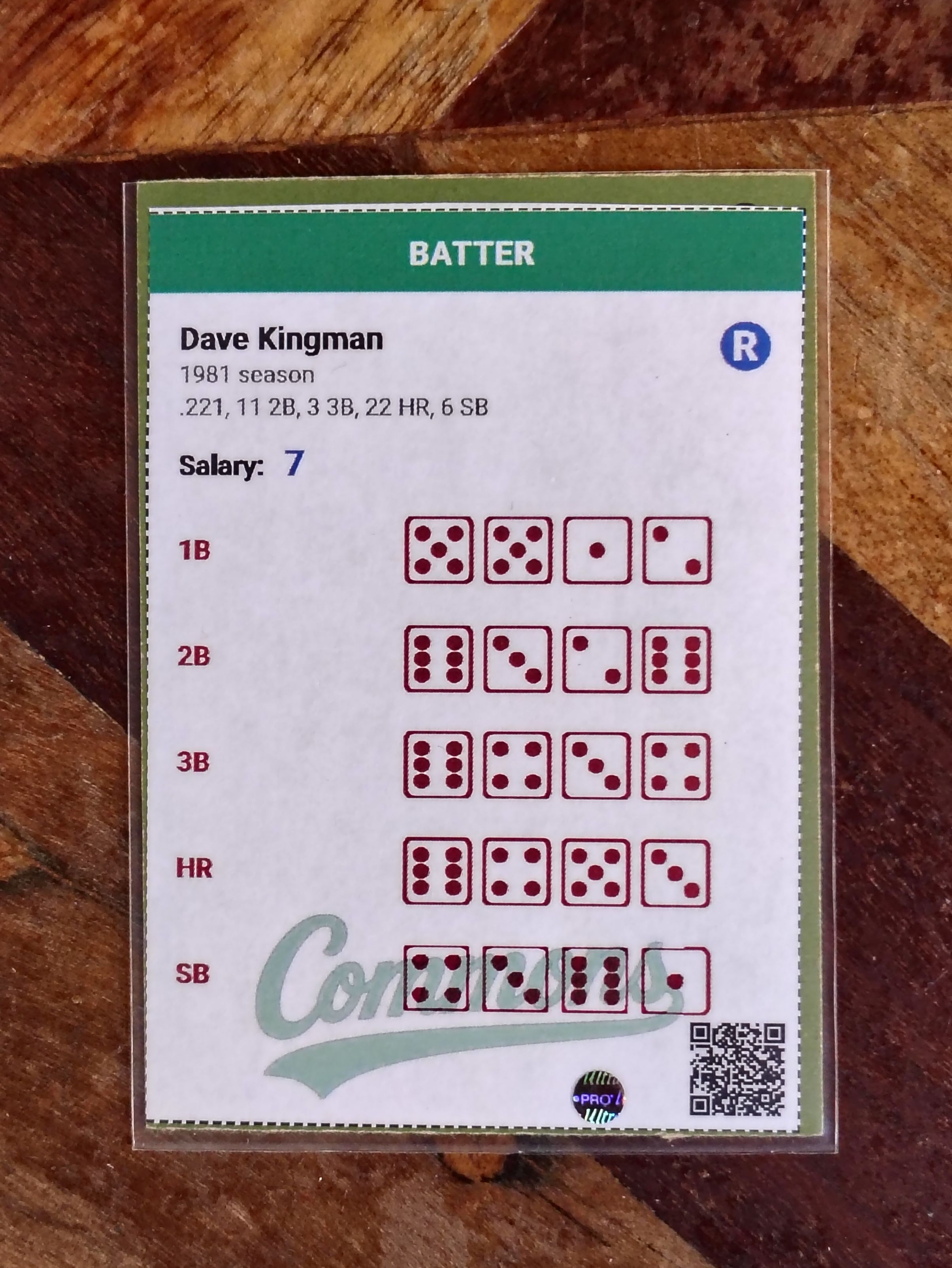
Five Possible Swing Outcomes:
- Single: Roll is ≥ 1B threshold but < 2B threshold
- Double: Roll is ≥ 2B threshold but < 3B threshold
- Triple: Roll is ≥ 3B threshold but < HR threshold
- Home Run: Roll is ≥ HR threshold
- Out: Roll is below 1B threshold
Phase 4: After the Hit
- Batter's Team: Advance Runners?
- Runners automatically advance as far as needed to vacate their base for the runner behind them
- Play "Advance" cards to move runners one additional base
- One advance card per runner (but you can use multiple cards if you have multiple runners)
- Cannot use advance cards on the batter who just hit
Turn Complete! Move to the next batter and start a new turn. When 3 outs are recorded, the half-inning is over.
Understanding Pitcher Cards
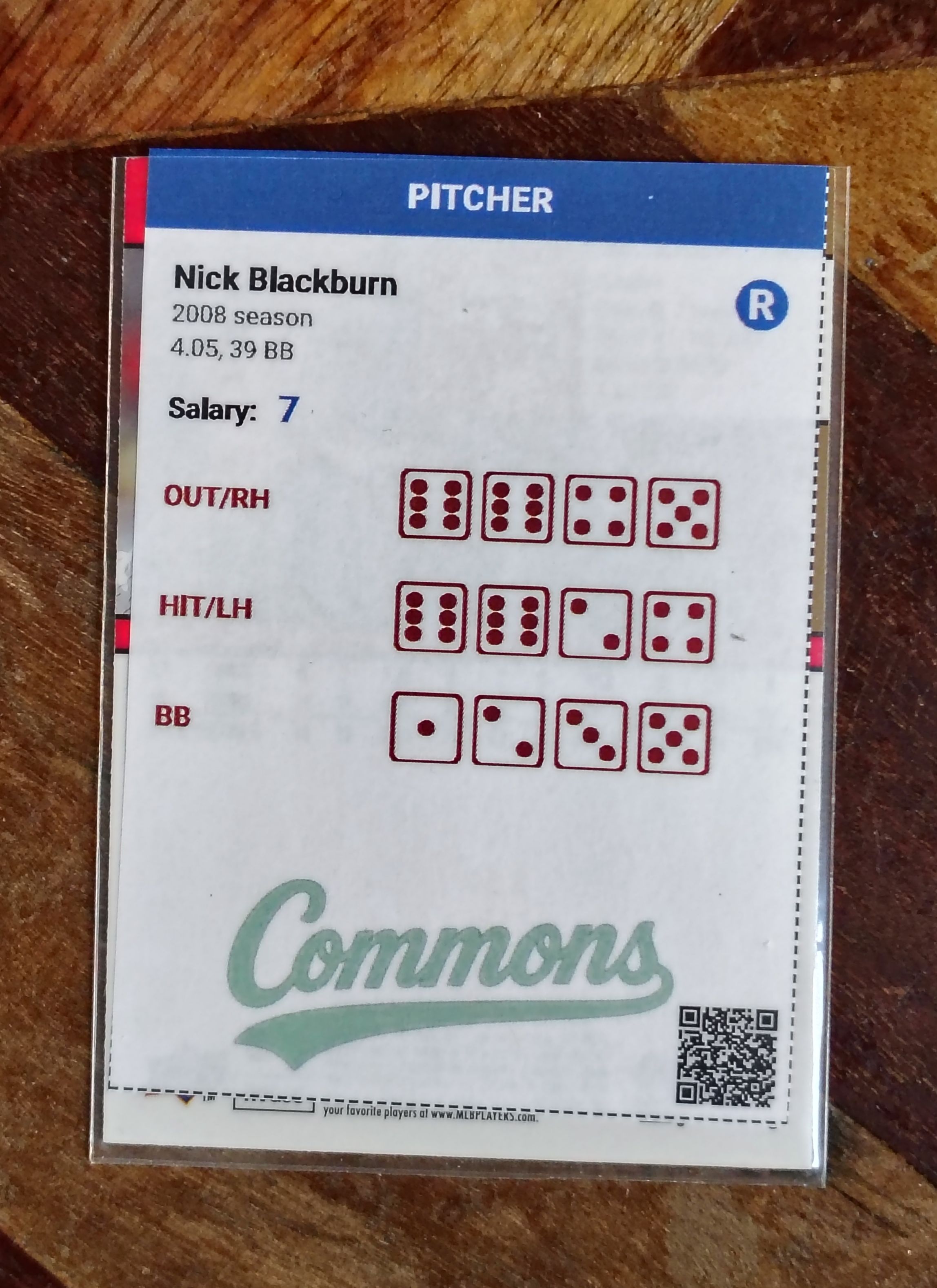
Pitcher cards work a little differently than batter cards. Here's what you need to know:
The 4.00 ERA Baseline
Commons Baseball treats an ERA of 4.00 as neutral (historically, the median ERA is about 4.17). This means:
- Pitchers with ERA under 4.00: Have "OUT" thresholds (they're better at getting batters out)
- Pitchers with ERA over 4.00: Have "HIT" thresholds (they give up more hits)
- Pitchers close to 4.00: Might have OUT thresholds against lefties and HIT against righties
Left vs. Right Matters
Pitcher cards show different thresholds when facing left-handed vs. right-handed batters. This reflects real baseball, where pitchers typically have an advantage against same-handed batters (righty vs. righty, lefty vs. lefty).
Switch Hitters - Best of Both Worlds
Batters who hit both left and right automatically bat opposite to the pitcher's throwing hand. So a switch hitter always gets the platoon advantage - batting left against righties and right against lefties. Check the handedness on both cards to determine which thresholds to use!
Advanced Strategies
Swinging for the Fences
Any batter can choose to swing for the fences right before rolling for a hit. When you do:
- The Good: Any hit that would be a 2B, 3B, or HR automatically becomes a home run
- The Bad: Any roll that would have been a single (1B) is an automatic out instead
This is a high-risk, high-reward strategy. Use it when you need a big hit and are willing to gamble!
Pinch Hitting Strategy
Remember, pinch hitting is only available for players who played for multiple teams during the card season (you'll see stats for both teams on the card back). Some cards say "Now with Rangers" or similar text, but that's not always accurate - always check the stats!
When you pinch hit, you discard the current batter permanently and bring in any remaining batter from your roster. This is great in a pinch (pun intended), but be careful - if you burn through too many batters, you might run out!
When to Use Baseball Gods Cards
You only get a few of these, so use them strategically:
- Hit Cards: Save for crucial moments with runners in scoring position, or when facing a dominant pitcher
- Out Cards: Use against their best batters, or to stop a rally with runners on base
- Advance Cards: Perfect for getting runners home from third, or advancing to scoring position
- Challenge Cards: Only 2 of these! Save them for the most critical situations
Running Out of Players (Extra Innings)
Games can go into extra innings, and if they do, you might run out of pitchers or batters. Here's what happens:
Running Out of Pitchers
If you run out of pitchers (from going past 10 innings or skipping pitchers), your opponent chooses a pitcher from your discard pile for you to use for the rest of the game. They'll pick your worst one, of course - this is a big disadvantage!
Running Out of Batters
If you run out of batters (from pinch hitting or scoring too much :)), use your discarded players who did not score, but only after your opponent removes 5 cards of their choosing.
Stealing Bases
If there's a runner on first base and second base is open, the batting team can attempt a steal after the pitch is delivered (but before swinging).
- Roll the die and check the back of the runner's card for steal thresholds
- If successful, the runner advances to the next base
- If unsuccessful, the runner is out
- Special rule: If there are already 2 outs and the runner is caught stealing, the inning ends but the current batter remains in the lineup for the next inning
The pitch is not re-delivered after a steal attempt - successful or not.
Bunting
Instead of swinging, a batter can choose to bunt. When bunting:
- All runners (except a runner on third) advance one base
- The batter is automatically out
- Turn ends
Bunting is a strategic sacrifice play to move runners into scoring position.
Quick Reference - Turn Summary
| Step | Who | Action |
|---|---|---|
| 1 | Pitcher | Play Out/2Out card? (optional) |
| 2 | Batter | Challenge? (optional) |
| 3 | Pitcher | Roll to pitch or intentional walk |
| 4 | Batter | Attempt steal? (optional, if runner on 1st) |
| 5 | Batter | Pinch hit? (optional, if multi-team player) |
| 6 | Batter | Play Hit/Double card? (optional) |
| 7 | Pitcher | Challenge? (optional) |
| 8 | Batter | Swing for fences? (optional) |
| 9 | Batter | Roll to swing or bunt |
| 10 | Batter | Play Advance cards? (optional, if hit) |
Tips for Your First Game
- Don't worry about perfection: Your first game may be messy and that's okay! Learn as you play.
- Keep the turn sequence handy: Bookmark this page or print out the quick reference table above.
- Save your baseball gods: New players tend to use them too early. Hold onto them for critical moments!
- Track your outs: Keep each stack of 3 outs per inning in its own pile, this helps keep track of the inning as well.
Ready to Play?
That's everything you need to know! Commons Baseball might seem complex at first, but after a few turns it becomes second nature. The beauty of the game is that it rewards strategic thinking while staying true to real baseball statistics.
Grab your cards, find an opponent, and have fun bringing those commons back to life!
Play ball!